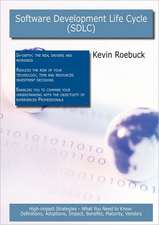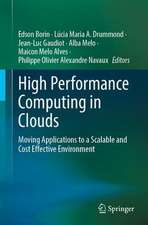MySQL Crash Course
Autor Ben Fortaen Limba Engleză Paperback – 7 ian 2025
Preț: 170.37 lei
Preț vechi: 212.97 lei
-20% Nou
32.60€ • 34.19$ • 27.14£
Carte disponibilă
Livrare economică 11-25 martie
Livrare express 25 februarie-01 martie pentru 30.75 lei
Specificații
ISBN-10: 0138223025
Pagini: 304
Dimensiuni: 175 x 229 x 18 mm
Greutate: 0.56 kg
Ediția:2. Auflage
Editura: Pearson
Notă biografică
Ben Forta is Adobes Senior Director of Education Initiatives and has more than three decades of experience in the computer industryin product development, support, training, and product marketing. He is the author of the best-selling Sams Teach Yourself SQL in 10 Minutes (as well as spinoff titles like this one and versions on SQL Server T-SQL, Oracle PL/SQL, and MariaDB), Learning Regular Expressions, and Captain Code, which teaches Python to younger coders (and those young at heart), Java, Windows, and more. He has extensive experience in database design and development, has implemented databases for several highly successful commercial software programs and websites, and is a frequent lecturer and columnist on application development and Internet technologies. Ben lives in Oak Park, Michigan, with his wife, Dr. Marcy Forta, and their children. He welcomes your email at ben@forta.com and invites you to visit his website at http://forta.com.
Cuprins
Chapter 1 Understanding SQL 1
Database Basics 1
What Is a Database? 2
Tables 2
Columns and Datatypes 3
Rows 4
Primary Keys 4
What Is SQL? 6
Try It Yourself 6
Summary 7
Chapter 2 Introducing MySQL 9
What Is MySQL? 9
Client/Server Software 9
MySQL Versions 10
MySQL Tools 11
mysql Command-Line Utility 11
MySQL Workbench 12
Other Tools 13
Summary 13
Chapter 3 Working with MySQL 15
Using the Command-Line Tool 15
Selecting a Database 16
Learning About Databases and Tables 17
Using MySQL Workbench 20
Getting Started 20
Using MySQL Workbench 21
Selecting a Database 22
Learning About Databases and Tables 22
Executing SQL Statements 23
Next Steps 23
Summary 24
Chapter 4 Retrieving Data 25
The SELECT Statement 25
Retrieving Individual Columns 25
Retrieving Multiple Columns 27
Retrieving All Columns 29
Retrieving Distinct Rows 29
Limiting Results 31
Using Fully Qualified Table Names 32
Using Comments 33
Summary 34
Challenges 34
Chapter 5 Sorting Retrieved Data 35
Sorting Data 35
Sorting by Multiple Columns 37
Sorting by Column Position 38
Specifying Sort Direction 39
Summary 41
Challenges 42
Chapter 6 Filtering Data 43
Using the WHERE Clause 43
WHERE Clause Operators 44
Checking Against a Single Value 45
Checking for Nonmatches 46
Checking for a Range of Values 47
Checking for No Value 48
Summary 49
Challenges 49
Chapter 7 Advanced Data Filtering 51
Combining WHERE Clauses 51
Using the AND Operator 51
Using the OR Operator 52
Understanding the Order of
Evaluation 53
Using the IN Operator 54
Using the NOT Operator 56
Summary 58
Challenges 58
Chapter 8 Using Wildcard Filtering 59
Using the LIKE Operator 59
The Percent Sign (%) Wildcard 60
The Underscore (_) Wildcard 61
Tips for Using Wildcards 63
Summary 63
Challenges 63
Chapter 9 Searching Using Regular Expressions 65
Understanding Regular Expressions 65
Using MySQL Regular Expressions 66
Basic Character Matching 66
Performing OR Matches 68
Matching One of Several Characters 68
Matching Ranges 70
Matching Special Characters 70
Matching Character Classes 72
Matching Multiple Instances 72
Anchors 74
Summary 75
Challenges 76
Chapter 10 Creating Calculated Fields 77
Understanding Calculated Fields 77
Concatenating Fields 78
Using Aliases 80
Performing Mathematical Calculations 81
Summary 83
Challenges 83
Chapter 11 Using Data Manipulation Functions 85
Understanding Functions 85
Using Functions 86
Text Manipulation Functions 86
Date and Time Manipulation Functions 88
Numeric Manipulation Functions 91
Summary 92
Challenges 92
Chapter 12 Summarizing Data 93
Using Aggregate Functions 93
The Avg() Function 94
The Count() Function 95
The Max() Function 96
The Min() Function 97
The Sum() Function 98
Aggregates on Distinct Values 99
Combining Aggregate Functions 100
Summary 101
Challenges 101
Chapter 13 Grouping Data 103
Understanding Data Grouping 103
Creating Groups 104
Filtering Groups 105
Grouping and Sorting 107
Combining Grouping and Data Summarization 109
SELECT Clause Ordering 110
Summary 110
Challenges 110
Chapter 14 Working with Subqueries 113
Understanding Subqueries 113
Filtering by Subquery 113
Using Subqueries As Calculated Fields 117
Summary 119
Challenges 119
Chapter 15 Joining Tables 121
Understanding Joins 121
Understanding Relational Tables 121
Why Use Joins? 122
Creating a Join 123
The Importance of the WHERE Clause 124
Inner Joins 127
Joining Multiple Tables 128
Summary 130
Challenges 130
Chapter 16 Creating Advanced Joins 133
Using Table Aliases 133
Using Different Join Types 134
Self-Joins 134
Natural Joins 136
Outer Joins 137
Using Joins with Aggregate Functions 138
Using Joins and Join Conditions 139
Summary 140
Challenges 140
Chapter 17 Combining Queries 141
Understanding Combined Queries 141
Creating Combined Queries 141
Using UNION 141
UNION Rules 143
Including or Eliminating Duplicate Rows 144
Sorting Combined Query Results 145
Summary 146
Challenges 146
Chapter 18 Full-Text Searching 147
Understanding Full-Text Searching 147
Using Full-Text Searching 148
Performing Full-Text Searches 148
Using Query Expansion 151
Boolean Text Searches 153
Full-Text Searching Notes 156
Summary 157
Challenges 157
Chapter 19 Inserting Data 159
Understanding Data Insertion 159
Inserting Complete Rows 159
Inserting Multiple Rows 163
Inserting Retrieved Data 164
Summary 166
Challenges 166
Chapter 20 Updating and Deleting Data 167
Updating Data 167
Deleting Data 169
Guidelines for Updating and Deleting Data 170
Summary 171
Challenges 171
Chapter 21 Creating and Manipulating Tables 173
Creating Tables 173
Basic Table Creation 173
Working with NULL Values 175
Primary Keys Revisited 176
Using AUTO_INCREMENT 177
Specifying Default Values 178
Engine Types 179
Updating Tables 180
Deleting Tables 182
Renaming Tables 182
Summary 182
Challenges 182
Chapter 22 Using Views 183
Understanding Views 183
Why Use Views 184
View Rules and Restrictions 185
Using Views 185
Using Views to Simplify Complex Joins 185
Using Views to Reformat
Retrieved Data 186
Using Views to Filter Unwanted Data 188
Using Views with Calculated Fields 188
Updating Views 189
Summary 190
Challenges 190
Chapter 23 Working with Stored Procedures 191
Understanding Stored Procedures 191
Why Use Stored Procedures 192
Using Stored Procedures 193
Executing Stored Procedures 193
Creating Stored Procedures 193
The DELIMITER Challenge 194
Dropping Stored Procedures 195
Working with Parameters 195
Building Intelligent Stored Procedures 199
Inspecting Stored Procedures 201
Summary 202
Challenges 202
Chapter 24 Using Cursors 203
Understanding Cursors 203
Working with Cursors 204
Creating Cursors 204
Opening and Closing Cursors 205
Using Cursor Data 206
Summary 210
Chapter 25 Using Triggers 211
Understanding Triggers 211
Creating Triggers 212
Dropping Triggers 213
Using Triggers 213
INSERT Triggers 213
DELETE Triggers 214
UPDATE Triggers 215
More on Triggers 216
Summary 216
Chapter 26 Managing Transaction Processing 217
Understanding Transaction Processing 217
Controlling Transactions 219
Using ROLLBACK 219
Using COMMIT 220
Using Savepoints 220
Changing the Default Commit Behavior 221
Summary 222
Chapter 27 Globalization and Localization 223
Understanding Character Sets and Collation Sequences 223
Working with Character Sets and Collation Sequences 224
Summary 226
Chapter 28 Managing Security 227
Understanding Access Control 227
Managing Users 228
Creating User Accounts 229
Deleting User Accounts 230
Setting Access Rights 230
Changing Passwords 233
Summary 234
Chapter 29 Database Maintenance 235
Backing Up Data 235
Performing Database Maintenance 235
Diagnosing Startup Problems 237
Reviewing Log Files 237
Summary 238
Chapter 30 Improving Performance 239
Improving Performance 239
Summary 240
Appendix A Getting Started with MySQL 241
What You Need 241
Obtaining the Software 242
Installing the Software 242
Preparing to Read This Book 242
Appendix B The Example Tables 243
Understanding the Example Tables 243
Table Descriptions 244
The vendors Table 244
The products Table 244
The customers Table 245
The orders Table 245
The orderitems Table 246
The productnotes Table 246
Creating the Sample Tables 247
Using Data Import 247
Using SQL Scripts 248
Appendix C MySQL Statement Syntax 249
ALTER TABLE 249
COMMIT 249
CREATE INDEX 250
CREATE PROCEDURE 250
CREATE TABLE 250
CREATE USER 250
CREATE VIEW 251
DELETE 251
DROP 251
INSERT 251
INSERT SELECT 251
ROLLBACK 252
SAVEPOINT 252
SELECT 252
START TRANSACTION 252
UPDATE 252
Appendix D MySQL Datatypes 253
String Datatypes 253
Numeric Datatypes 255
Date and Time Datatypes 256
Binary Datatypes 256
Appendix E MySQL Reserved Words 257
9780138223021 TOC 10/2/2023















